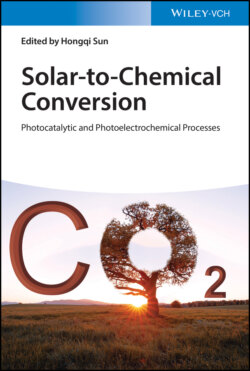Читать книгу Solar-to-Chemical Conversion - Группа авторов - Страница 36
3.6 Carbon Fixation
ОглавлениеCapture of CO2 and reduction to products such as CO, HCOOC, H2CO, CH3OH, or CH4 are a principal target for artificial photosynthesis in the quest for solar fuels, as discussed in detail elsewhere in this book. A strictly biomimetic approach does not seem ideal in this case compared to photocatalytic and (photo)electrochemical reduction of CO2. However, there are still lessons to be learned from biology, and here we will briefly cover the CO2 fixation process in natural photosynthesis, which is carried out by the enzyme RuBisCO (ribulose‐1,5‐bisphosphate carboxylase/oxygenase) [4]. RuBisCO is considered the most abundant protein on earth [347, 348] and uses CO2 to convert the five‐carbon molecule ribulose‐1,5‐bisphosphate (RuBP) to two three‐carbon 3‐phosphoglycerate (3PGA) molecules, one of which incorporates the CO2‐derived carbon atom. This carboxylation reaction provides the substrate for subsequent reactions in the Calvin–Benson cycle that phosphorylate and reduce 3PGA using ATP and NADPH to produce glyceraldehyde 3‐phosphate (G3P), the precursor molecule of glucose and other carbohydrates. In most photosynthetic organisms RuBisCO is present as a complex composed of eight copies of large (L) proteins and eight copies of small (S) proteins, L8S8 [349]. The active form of the enzyme is generated by carbamylation of an active site lysine residue [350] via reaction with CO2 and subsequent binding of Mg2+ at the carbamate. This is the form that binds RuBP, at the Mg2+ ion [351]. The carboxylation reaction is thought to proceed by initial creation of the enediol form of RuBP, which reacts with CO2 and is hydrated before C—C bond cleavage and release of the two 3PGA molecules (Figure 3.13).
Figure 3.13 Reaction mechanism of RuBisCO proposed by Taylor and Andersson.
Source: Taylor and Andersson [351].
RuBisCO evolved at a time when the atmosphere of our planet was much richer in CO2 and did not contain much O2. The oxygenation of the atmosphere posed a serious challenge for RuBisCO because O2 is a competitive substrate to CO2. Binding of O2 by RuBisCO leads to an alternative reaction pathway that results in oxygenation of RuBP. This is an unproductive pathway (photorespiration) that leads to creation of 2‐phosphoglycolate (2PGA) and eventual loss of previously fixed CO2. Although several adaptations at the cellular or metabolic level exist in biology to deal with this problem, evolution has not come up with a “solution” at the molecular level, i.e. with restriction of oxygenase activity by adaptation of the enzyme itself. The inability of RuBisCO to discriminate strongly between CO2 and O2 is considered to be the reason for the utilization of very large quantities of the enzyme by photosynthetic organisms and is viewed as the primary reason for the low overall efficiency of natural photosynthesis [352–355].
